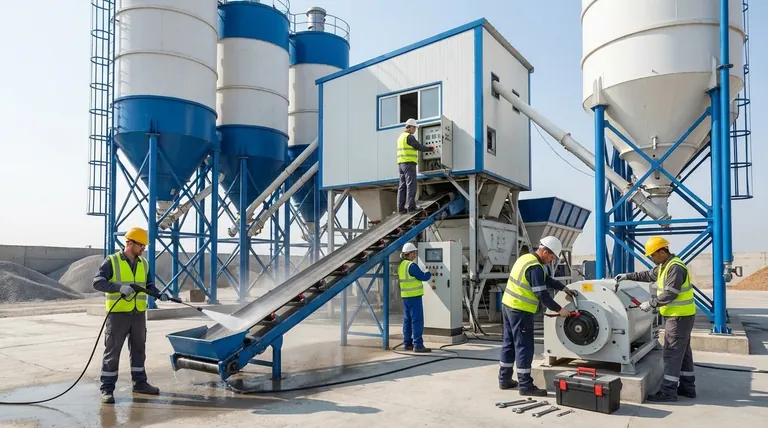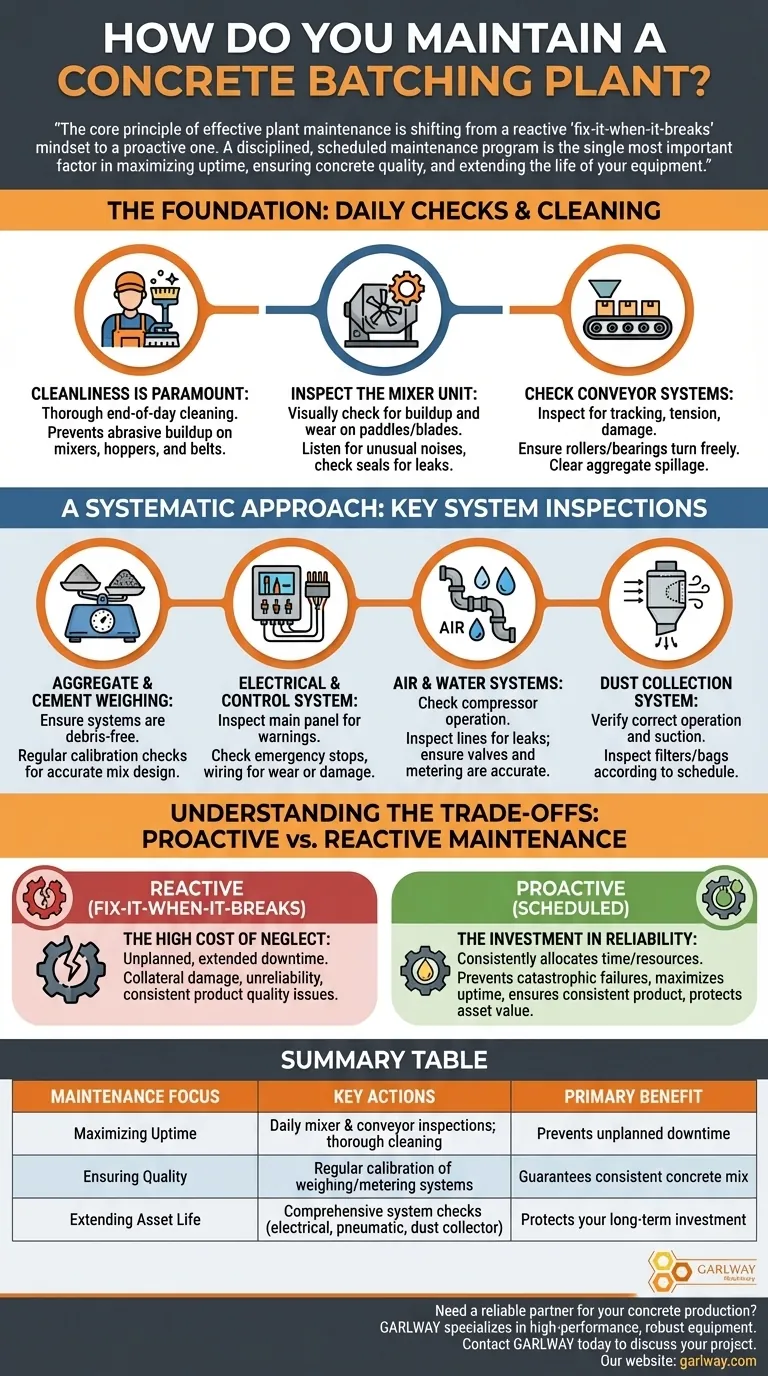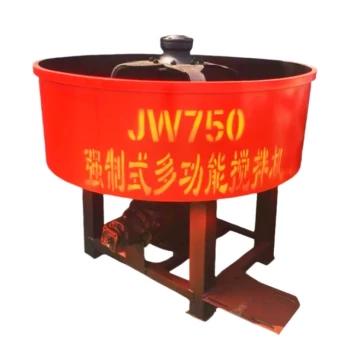Properly maintaining a concrete batching plant is a continuous process of systematic inspection, cleaning, and immediate repair of all key systems. It involves daily checks of high-wear components like the mixer and conveyors, regular verification of weighing and metering systems, and a disciplined approach to addressing any sign of wear or damage before it leads to failure.
The core principle of effective plant maintenance is shifting from a reactive "fix-it-when-it-breaks" mindset to a proactive one. A disciplined, scheduled maintenance program is the single most important factor in maximizing uptime, ensuring concrete quality, and extending the life of your equipment.

The Foundation: Daily Checks and Cleaning
Your daily routine forms the bedrock of a reliable plant. These tasks are non-negotiable for preventing the small issues that grow into costly shutdowns.
Cleanliness is Paramount
At the end of each production day, the plant must be thoroughly cleaned. Hardened concrete buildup is abrasive, adds weight to components, and can throw off the accuracy of weighing systems.
Proper cleaning prevents this buildup on mixers, hoppers, and conveyor belts, making visual inspections far more effective.
Inspect the Mixer Unit
The mixer is the heart of your plant. Visually inspect the interior for any concrete buildup and check mixer paddles or blades for signs of excessive wear.
Listen for unusual noises during operation and check all seals for leaks. Addressing mixer issues immediately is critical to maintaining concrete quality.
Check Conveyor Systems
Visually inspect all conveyor belts for proper tracking, tension, and signs of tearing or damage. Check rollers and bearings to ensure they are turning freely.
Clear away any aggregate spillage around the conveyors to prevent it from damaging the system or creating a safety hazard.
A Systematic Approach: Key System Inspections
Beyond daily checks, a more thorough inspection of the plant's core systems should be scheduled regularly. This ensures every component is functioning as intended.
Aggregate and Cement Weighing Systems
Accurate batching is essential for producing quality concrete. The weighing systems, including hoppers and load cells, are critical.
Ensure these systems are free from debris that could affect their accuracy. Regular calibration checks are necessary to guarantee you are meeting mix design specifications.
The Electrical and Control System
The plant’s automation relies on its electrical and PLC (Programmable Logic Controller) system. Inspect the main control panel for any warning lights or error messages.
Check that all emergency stops are functioning correctly. Visually inspect wiring for any signs of wear, damage, or loose connections that could cause a malfunction.
Air and Water Systems
The pneumatic system controls gates and valves throughout the plant. Check the air compressor for proper operation and drain any accumulated water from the air tanks.
Inspect all air and water lines for leaks. Ensure valves are opening and closing fully and that the water metering system is accurate.
Dust Collection System
The dust collector is vital for safety, environmental compliance, and equipment longevity. Check that the system is operating correctly and creating suction.
Inspect the filters or bags according to the manufacturer's schedule and replace them as needed to ensure efficient dust capture.
Understanding the Trade-offs: Proactive vs. Reactive Maintenance
Every maintenance decision is a choice between two philosophies, each with vastly different outcomes for your operation.
The High Cost of Neglect
A reactive approach—only fixing components when they fail—inevitably leads to unplanned and extended downtime. This not only halts production but often results in more significant, collateral damage to other parts of the plant.
This strategy trades short-term convenience for long-term costs, unreliability, and inconsistent product quality.
The Investment in Reliability
Proactive, scheduled maintenance is an investment in operational excellence. It requires allocating time and resources consistently but pays for itself by preventing catastrophic failures.
This approach ensures your plant runs efficiently, produces a consistent product, and protects the value of your most critical asset.
Creating Your Maintenance Plan
Use your primary operational goal to guide the focus of your maintenance program.
- If your primary focus is maximizing uptime: Prioritize daily inspections and cleaning of high-wear mechanical components like the mixer and conveyor systems.
- If your primary focus is consistent concrete quality: Emphasize the regular cleaning, inspection, and calibration of all weighing and metering systems for cement, aggregates, water, and additives.
- If your primary focus is long-term asset life: Implement a comprehensive schedule covering every system, from the electrical controls to the dust collector, addressing even minor issues promptly.
Ultimately, a disciplined maintenance schedule is the defining factor between a plant that is merely functioning and one that is truly productive.
Summary Table:
| Maintenance Focus | Key Actions | Primary Benefit |
|---|---|---|
| Maximizing Uptime | Daily mixer & conveyor inspections; thorough cleaning | Prevents unplanned downtime |
| Ensuring Quality | Regular calibration of weighing/metering systems | Guarantees consistent concrete mix |
| Extending Asset Life | Comprehensive system checks (electrical, pneumatic, dust collector) | Protects your long-term investment |
Need a reliable partner for your concrete production? Proper maintenance starts with durable equipment. GARLWAY specializes in high-performance construction machinery, including robust concrete batching plants, mixers, and winches designed for construction companies and contractors worldwide. Our equipment is engineered for easier maintenance and longer service life, helping you maximize productivity. Contact GARLWAY today to discuss your project needs and discover how we can support your success.
Visual Guide

Related Products
- HZS180 Ready Mix Concrete Plant for Foundations with Sand and Cement
- HZS75 Concrete Batching Plant Cement Mixer Price Concrete Mixer Bunnings Mixing Plant
- HZS120 Ready Mix Concrete Batching Plant Commercial Mud Cement Mixer
- HZS35 Small Cement Concrete Mixing Batch Plant
- Portable Concrete Mixer Machine Equipment for Mixing Concrete
People Also Ask
- What are the disadvantages of ready mixed concrete? Navigate Logistical & Cost Risks
- What are the factors influencing choice of a concrete mixing plant? Key Considerations for Efficiency
- What are the advantages of a concrete plant? Achieve Consistent Quality & Efficiency for Large-Scale Projects
- How much does a batching plant cost? Uncover the True Investment for Your Project
- How does ready-mix work? A Guide to Efficient, High-Quality Concrete Delivery



















